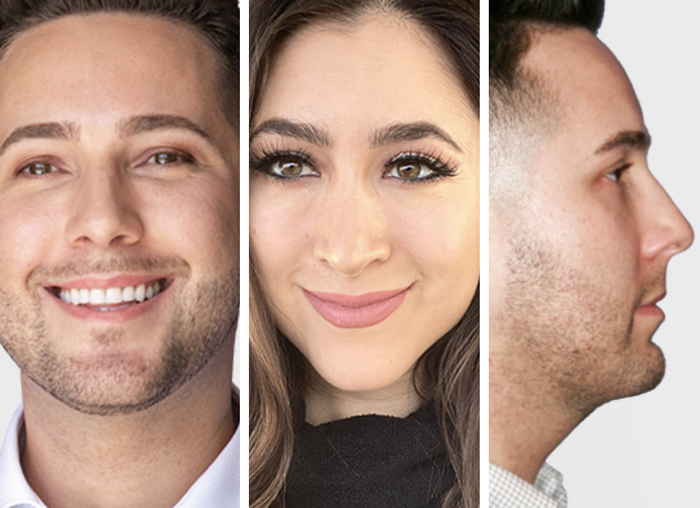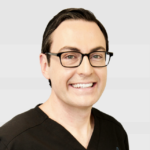San Francisco Plastic Surgeon Dr. Evan Ransom is a top provider of blepharoplasty in the Bay Area. For many people, the first signs of aging occur around the eyes. This can be dark circles, hollowness, sagging skin, or eyelid bags – and can make you look tired or even sad. Aesthetic issues with the eyelids are not always related to age, however, and actually can be hereditary in some patients. Countless creams, lotions, and serums are marketed for eyelids and upper cheeks, but these frequently fall short because they really only treat the skin surface rather than the deeper problems in the tissue.
Eyelid surgery (blepharoplasty) can be used to treat a wide variety of aesthetic issues in the eyelid and surrounding tissues. Some examples of San Francisco blepharoplasty include excess upper or lower eyelid skin, fat bags or sagging lower eyelids, uneven or droopy upper eyelids, and hollow areas under the eyes. Multiple different blepharoplasty surgical techniques exist and can be tailored for your specific concerns. Rejuvenation of the eyes can make you look younger, healthier, and more rested. If the eyes really are the window of the soul, why not make them look as beautiful and fresh as possible? Dr. Ransom, San Francisco blepharoplasty specialist, will discuss the best options for you during your confidential consultation at his office in the Bay Area.
Explore our
Patient Gallery
*Actual patients in photos

-
Lower Blepharoplasty (Lower Eyelid Lift)
Lower eyelid fullness and dark circles around the eyes make you look tired – no matter how good you feel or how much sleep you get! This is a common problem as we age, and is related to a number of changes in the face. First, the thin, “crepey” skin in the lower eyelid is stretched and dragged down as gravity pulls on the relatively heavy cheek tissues. This exposes the underlying bone of the eye socket (orbital rim), and can give a hollow appearance. Second, the fat pads that surround the eyeball begin to bulge forward. This make a line between the eyelid and the cheek and gives a “double contour” effect – where there are two curves in the lower eyelid and upper cheek, rather than the more youthful, smooth, single contour.
When there is too much skin or bulging fat in the lower eyelids, San Francisco Blepharoplasty Plastic Surgeon Dr. Ransom can treat this complex area with a surgical procedure called a lower blepharoplasty (lower eyelid lift). There are multiple approaches to lower eyelid rejuvenation, and different blepharoplasty patients require specific techniques. Dr. Ransom, San Francisco blepharoplasty expert, performs a careful examination of each San Francisco Bay Area blepharoplasty patient to determine the laxity (looseness) of the eyelids, presence and amount of excess skin, and distribution of adipose tissue (fat pads) around the eye and in the cheek. For younger blepharoplasty patients or those without any loose skin, the fat pads can be treated without making an incision in the eyelid skin. This minimizes the risk of lower eyelid position problems and helps to speed up recovery. For the Bay Area blepharoplasty patients that have loose eyelids, excess skin, or a hollow-appearance, San Francisco Blepharoplasty Plastic Surgeon Dr. Ransom performs the latest technique in lower blepharoplasty, which uses your own fat pads to fill in the hollow areas and removes extra loose skin.
Upper Blepharoplasty (Upper Eyelid Lift)
Heavy or droopy upper eyelids can make you look exhausted – even after a full night’s sleep! This is a common problem as we age, with extra soft tissue hiding the upper eyelid crease, making it difficult to apply eye makeup, and in severe cases, limiting your peripheral vision. This issue may be related to a variety of anatomic factors, including loose skin, excess fat, or even a heavy forehead or brow weighing down the eyelids. When there is too much skin or fat, San Francisco Blepharoplasty Cosmetic Surgeon Dr. Ransom can remove this tissue with a simple surgical procedure called an upper blepharoplasty (upper eyelid lift). San Francisco upper blepharoplasty is performed with local anesthesia, meaning patients are awake but will not feel any pain during surgery. In some blepharoplasty candidates, the appearance of drooping upper eyelids is related to a heavy or sagging forehead and brow region (brow ptosis). This problem may be referred to as “lateral hooding” because the skin of the sides of the forehead weighs down the upper eyelids more significantly on the sides, and creates a curtain or a fold over this area. For these patients, a brow lift is a great treatment, either alone or combined with an upper eyelid lift. Treating the brow and forehead region, along with the upper eyelids, ensures a natural-appearing and long-lasting result.
Asian Blepharoplasty (Double Eyelid or Eyelid Crease Surgery)
Subtle anatomical differences exist in the structure of the upper eyelids in people of Asian descent relative to those of Caucasian or African descent. The fuller appearance of the Asian upper eyelid, and the absence of a visible crease, are related to the attachment of the muscle that raises the upper eyelid and the placement of the fat that surrounds and protects the eye. In San Francisco blepharoplasty patients who desire a visible upper eyelid crease, a simple surgical procedure called Asian blepharoplasty (sometimes referred to as double eyelid surgery) can be performed. Asian blepharoplasty is a minimally-invasive procedure and can be performed with local anesthesia or minimal sedation in the office or ambulatory surgery center. With appropriate activity restrictions, our San Francisco Bay Area blepharoplasty patients are typically able to return to school or work within a couple of days of treatment.
All types of blepharoplasty surgery can be performed with local anesthesia only or with mild sedation, depending on patient preference, and may be combined with other surgical and non-surgical facial aesthetic procedures such as rhytidectomy (facelift), browlift, or laser resurfacing for fine wrinkles and uneven pigment. For more information about eyelid procedures, please contact Dr. Ransom, San Francisco blepharoplasty specialist, to schedule your consultation in our office in the Bay Area!
Who is a candidate?
Anyone who wants to improve the appearance of the eyelids is a candidate for blepharoplasty. For blepharoplasty patients with lower eyelid bags, extra or loose skin and muscle, tired-appearing eyes, or hollow eyes with dark circles, a lower eyelid lift is indicated. During your consultation, San Francisco Blepharoplasty Cosmetic Surgeon Dr. Ransom will closely examine your upper eyelid area, including skin laxity, position at rest, movement, eye closure, and tear film (lacrimal status, or dry eyes). Anyone with heavy upper eyelids, loose skin, or tired-appearing eyes may be a candidate for an upper eyelid lift.
In some cases, the unaesthetic appearance of the eyelids is related to a more complex medical issue. In the lower eyelids, this may include thyroid problems (myxedema). In the upper eyelids, there may be issues with the eyelid elevating muscles (levator palpebrae superioris); when this happens, the diagnosis is blepharoptosis, and the treatment may include a ptosis repair with or without an upper eyelid lift. In other cases, the sagging or baggy appearance of the upper eyelids is related to a heavy or falling forehead and eyebrow region; when this happens, a brow lift may be indicated, with or without an upper eyelid lift. Dr. Ransom, experienced blepharoplasty specialist, is happy to discuss these issues in detail with you during your consultation.
Dr. Ransom, skilled San Francisco blepharoplasty surgeon, see patients from all over Bay Area for an eyelid lift or blepharoplasty, including Mill Valley/Marin County, Napa/Sonoma, San Rafael/Petaluma, Hillsborough, San Mateo, Menlo Park, Orinda, Palo Alto, Piedmont, Walnut Creek and the world.
Frequently asked questions
Please note that all patients are different and individual healing times and results may vary. The statements regarding procedures and recovery made here are general rules.
Can Botox lift droopy eyelids?
Can droopy eyelids cause blurred vision?
Can I sleep on my side after eyelid surgery?
Can you get rid of hooded eyelids?
Can you go blind from blepharoplasty?
Does eyelid surgery leave scars?
How can I reduce eyelids?
How do you fix droopy eyelids?
How do you reduce bruising after eyelid surgery?
How is eyelid surgery performed?
How is upper eyelid surgery done?
How long after blepharoplasty do you see results?
How long are eyes blurry after blepharoplasty?
How long does droopy eyelid surgery last?
How long does it take for lower blepharoplasty scars to heal?
How long does it take to heal from upper eyelid surgery?
How long does eyelid surgery take?
Dr. Evan Ransom is an Ivy League-educated and Ivy League trained Facial Plastic and Reconstructive Surgeon. He is a Double Board Certified Head and Neck Surgeon and Facial Plastic and Reconstructive Surgery and fellowship-trained in facial plastic, reconstructive, and laser surgery. His practice is in the San Francisco Bay Area, serving patients from San Francisco, Oakland, Marin County, Palo Alto, Silicon Valley, Walnut Creek, the East Bay, and all over Northern California.
 (415) 550-1077
(415) 550-1077 San Francisco
San Francisco




